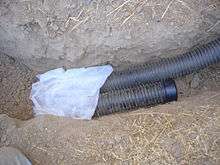Weeping tile

A weeping tile (also called a drain tile or perimeter tile[1]) is a porous pipe used for underground water collection or discharge. Named in the time period when drainpipes were made from terracotta tiles, the modern material is typically a length of corrugated plastic pipe with small slits or weep holes in it, which is buried surrounded by aggregate larger than the slits. The aggregate rocks prevent excessive soil from falling through the slits into the weeping tile. With this arrangement, water in the surrounding soil above the weeping tile flows into the weeping tile. The weeping tile then drains into a solid pipe leading to a discharge or directly into a sump, where the water can be removed by a sump pump.
Weeping tiles are often used for water drainage near basement foundations as a part of basement waterproofing, where they are called a French drain. They can be used in farmers' fields for the tile drainage of waterlogged fields. Such fields are called "tiled." Weeping tiles can be used anywhere that soil needs to be drained.
Weeping tile is used for the opposite reason in the septic drain fields for septic tanks. Clarified sewage from the septic tank is fed into weeping tiles buried shallowly in the drain field. The weeping tile spreads the liquid throughout the drain field.
References
- ↑ Gradwell, John B., and Malcolm Welch. Technology--shaping our world. South Holland, Ill.: Goodheart-Willcox, 1991. 116. Print.